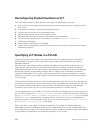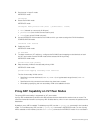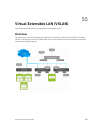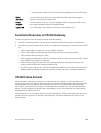When a VLT node detects peer up, it will not perform proxy ARP for the peer IP addresses. IP address
synchronization occurs again between the VLT peers.
Proxy ARP is enabled only if peer routing is enabled on both the VLT peers. If you disable peer routing by
using the no peer-routingcommand in VLT DOMAIN node, a notification is sent to the VLT peer to
disable the proxy ARP. If peer routing is disabled when ICL link is down, a notification is not sent to the
VLT peer and in such a case, the VLT peer does not disable the proxy ARP operation.
When the VLT domain is removed on one of the VLT nodes, the peer routing configuration removal will
be notified to the peer. In this case VLT peer node disables the proxy ARP. When the ICL link is removed
on one of the VLT nodes by using the no peer-link command, the ICL down event is triggered on the
other VLT node, which in turn starts the proxy ARP application. The VLT node, where the ICL link is
deleted, flushes the peer IP addresses and does not perform proxy ARP for the additional LAG hashed
ARP requests.
VLT Nodes as Rendezvous Points for Multicast Resiliency
You can configure virtual link trunking (VLT) peer nodes as rendezvous points (RPs) in a Protocol
Independent Multicast (PIM) domain.
PIM uses a VLT node as the RP to distribute multicast traffic to a multicast group. Messages to join the
multicast group (Join messages) and data are sent towards the RP, so that receivers can discover who the
senders are and begin receiving traffic destined for the multicast group.
To enable an explicit multicast routing table synchronization method for VLT nodes, you can configure
VLT nodes as RPs. Multicast routing needs to identify the incoming interface for each route. The PIM
running on both VLT peers enables both the peers to obtain traffic from the same incoming interface.
You can configure a VLT node to be an RP through the ip pim rp-address command in Global
Configuration mode. When you configure a VLT node as an RP, the (*, G) routes that are synchronized
from the VLT peers are ignored and not downloaded to the device. For the (S, G) routes that are
synchronized from the VLT peer, after the RP starts receiving multicast traffic via these routes, these (S, G)
routes are considered valid and are downloaded to the device. Only (S, G) routes are used to forward the
multicast traffic from the source to the receiver.
You can configure VLT nodes, which function as RP, as Multicast Source Discovery Protocol (MSDP)
peers in different domains. However, you cannot configure the VLT peers as MSDP peers in the same VLT
domain. In such instances, the VLT peer does not support the RP functionality.
If the same source or RP can be accessed over both a VLT and a non-VLT VLAN, configure better metrics
for the VLT VLANs. Otherwise, it is possible that one VLT node chooses a non-VLT VLAN (if the path
through the VLT VLAN was not available when the route was learned) and another VLT node selects a VLT
VLAN. Such a scenario can cause duplication of packets. ECMP is not supported when you configure VLT
nodes as RPs.
Backup RP is not supported if the VLT peer that functions as the RP is statically configured. With static RP
configuration, if the RP reboots, it can handle new clients only after it comes back online. Until the RP
returns to the active state, the VLT peer forwards the packets for the already logged-in clients. To enable
the VLT peer node to retain the synchronized multicast routes or synchronized multicast outgoing
interface (OIF) maps after a peer node failure, use the timeout value that you configured through the
992
Virtual Link Trunking (VLT)


















